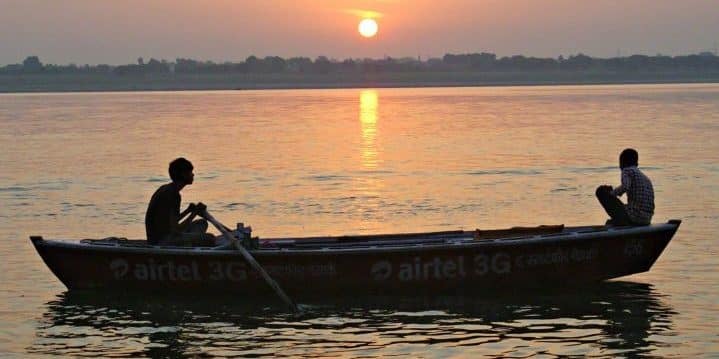
Varanasi, Grand Central Station for the Hindu pilgrimage, is in Uttar Pradesh, the fourth-largest of India’s 29 states. The holy city of Varanasi is on many wish lists, and for good reason. But you have to get up early to be a witness.

Morning prayer on the Ganges exists in many forms. Each one is about faith. The cycles of life take on myriad meanings upon our Earth. Before sunrise, you can witness an illuminating Ganges-riverside yanga, which is a sacred Hindu fire ritual offering sacrificial food and drink accompanied by beautifully sung mantras.

A sunrise boat ride on the Ganges is a journey into an alien universe of waterfront rituals including prayer, river baths, dental hygiene, laundry, and outdoor wood-fired cremations. A parade of ghats, open-air crematoriums, line the riverside, giving it a sacred factory setting. Witnessing a cremation makes many realize that, unfortunately, it isn’t until some of us are courting death that we realize what a pity it is to have not identified our passions and migrated toward them fearlessly. It hits everybody differently, but it definitely hits everyone. Witnessing bodies inside burning pyres recycle into the Vedic elements of their origin—earth, ether, fire, water, and wind—at Manikarnika Ghat on the bank of Mother Ganges in Varanasi is inevitably thought-provoking. Logs, arriving by boat, are stacked into towers while fire-tending morticians later uncover jewelry and gold tooth fillings. But not every Hindu is cremated. Exceptions include victims of snake bites, kids under seven years of age, pregnant women, and hippie-holy-man sadhus.

The riverside sidewalk in front of the ghats, hotels and other buildings doubles as ritual sites, strolling zones and spots for kids to play cricket. Sins cleansed, we strolled into town.

Every street in Varanasi leads to something interesting, or incredible. Akhara, run by ultimate fitness guru Mr. Siyaram, is a spirit-led outdoor wrestler’s gym where workout options include grappling in a sand pit and juggling ceremonial 30-pound Indian jori clubs. Mr. Siyaram, India’s answer to The Wrestler, was in a corner of the lots literally “rocking” the pushups by balancing on two boulders…

No visit to India comes without warning. You’ll hear about the risk of getting typhoid, dengue, hepatitis A, or chikungunya. Despite the probability of getting a bit of Delhi belly, I recommend trying some street food in Varanasi’s clustered old city. Street life here is synced chaos, with a chorus of honking and a visceral, winding marketplace with no sidewalks and endless alley offshoots. The sea of pedestrians fuses seamlessly with cars, trucks, buses, pushcart vendors, pedicabs, rickshaws, motorbikes, bicycles, and meandering cows—lots of them.
Things become even more complicated when the stated cows decide to lie down in the middle of traffic. Navigating your way on these narrow thoroughfares is like needling a burr through a Velcro forest; it’s the world’s best drivers in worst-case scenarios. Amid the physical and aural pandemonium, it is shocking that there are rarely accidents. Over three weeks, I saw two run-over dogs, but not one accident involving people or cars, not even a minor one. The most important component any vehicle is its horn, or bell. New York City seems like the countryside compared to this place.
Love it or not, your five senses come alive in the old town. By looking up, you add gigantic, sinister macaque monkeys spying from above to the mix. Most Hindus are vegetarians, but the magic they do with vegetables makes those dishes as satisfying as a T-bone. India is heaven for vegetarians. I’m not going into a foodie rant, but if you don’t already love it, please buck up and sample some Northern Indian cuisine. There are limited places to find alcohol or meat in any holy city in India. In this intimate society of three million (in a country with 1.3 billion people), consuming meat and alcohol is certainly frowned upon within view of the Ganges.
You have to come to India to discover why most visitors become ambassadors. Varanasi (and most of India) is an extreme example of what societies must do to outrun their consequences. India is a house of cards, always on the brink.

Banaras Hindu University, one of the country’s most storied educational institutions for Hindustani classical music training, is a green tree-lined reprieve from hectic downtown Varanasi. The specialized School of Performing Arts has four departments teaching North and South Indian classical music that delve deeply into vocals, tabla, sitar, violin, flute, and dance. While a Ph.D in all things sitar was doing a show-and-tell about stringed pumpkin-body instruments (yes, sitars are made out of pumpkins), you could feel his burning passion for the instrument.
All who enter and exit this fabled building touch the feet of and take a blessing from a statue of Saraswati, the Goddess of Knowledge, which includes music. Saraswati holds a veena, an ancient stringed instrument, and smiles coyly yet knowingly while returning your gaze. Across the Banaras Hindu University campus is the Bharat Kala Bhauan Museum, whose mind-bending multi-level collection includes 10th-century statues of every Indian deity and then some. On the edge of this campus stands Vishwanath Temple, another reminder of this country’s unimaginably deep connection to Hinduism.

Varanasi is the holy center of the Hindu universe, and you can’t walk three steps without being reminded of this. Watching devotees wash away their sins by taking a dip in the sacred river Ganges moved me to ask myself what the American version of this mode of purification is. In mass population terms, all I could come up with was large stadium sports or concerts. It might sometimes take an hour sitting in traffic to travel one mile here, but the spiraling, face-to-face encounters with humanity at its core are truly mind-blowing. Somehow cheerful or at least content, these people continuously stare squalor in the face. Their amazing will seems unbending once you meet it eye to eye.
Ganges-riverside Brijrama Palace is a gorgeous slice of royalty, and stylish place to overlook life along the Holy River. Nextdoor, the budget-oriented Ajay Guest House rooftop is the place to sneak a lowdown brew and moonrise over the Ganges.

Religion aside, this is a city of arts whose culture and university consistently crank out India’s first-rate artists. Kites flying at sunset serves as a preview of a Ganga riverside aarti (yes, more sacred prayer in the form of making a wish, lighting a candle and setting it afloat on the river). That’s when it hit me: The breaking news from one of the oldest continuously inhabited cities on Earth is that sacredness prevails and shall endure. Instead of being ripe for social upheaval, this quarter of India has ripened a tough skin for keeping on.
For more information about visiting Varanasi, Uttar Pradesh, and all of India visit Red Lantern Journeys and also uptourism.gov.in. Then, let Experience Varanasi show you the way. I enjoyed attending the Uttar Pradesh Travel Writers’ Conclave. Varanasi’s Ramada Plaza is a calming campus-enclave with an outdoor pool that’s a world removed from the mayhem.








Ghats are the stairways to the river and in Varanasi, I only saw two ghats that are cremation sites.
Meat can be found if you look in the right places. In New Delhi, the local Chilis served meat but McDonald’s and Carl’s Jr only had chicken.
Varanasi is an amazing city, which holds alot. Being Spiritual to Cultural, one can easily experience some great things.. Thank you for helping me to live my those amazing days again..
Ghats of Varanasi are regarded as the holiest pilgrimage places in the city of Varanasi, Uttar Pradesh. There are almost 100 ghats here that are visited by pilgrims who crowd the place to take a dip in the holy Ganga River. For more visit shorturl.at/cvxV4